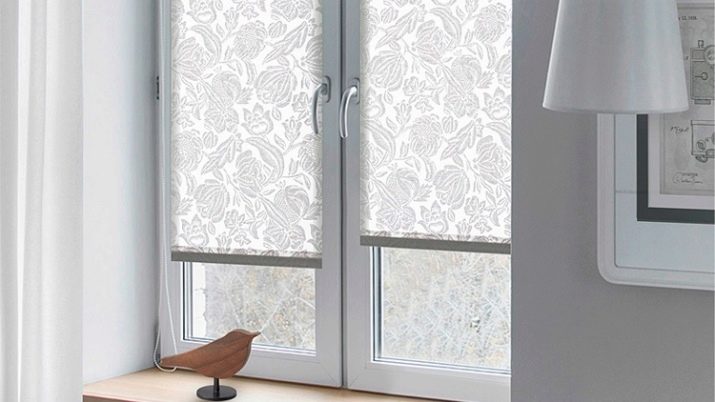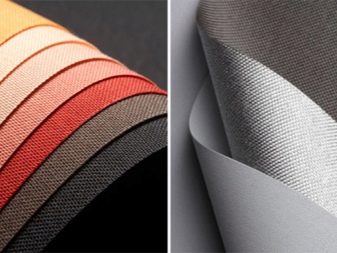Choosing a fabric for roller blinds

Roller blinds are a universal component of a modern interior. At the same time, such a window structure is practical, decorative and so functional that it is already difficult to imagine windows in the home and office without it.


Species overview
Traditionally, fabrics for roller blinds are natural, synthetic and mixed types. They differ both in texture and in the degree of transparency.
Transparent
In fact, this is the same tulle that practically does not shade and does not interfere with the penetration of sunlight and prying eyes into the room. In the interior, it has more of a decorative task than a practical purpose.
In living spaces, sheer roller blinds often complement heavy-duty curtains.

Opaque
This fabric is commonly known as blackout. It not only blocks the light from the street, but also absorbs a third of the noise from the outside. Materials in the blackout segment may differ depending on the manufacturer and their parameters. The surest way to recognize a real blackout is to put a switched on flashlight under the cloth. Light should not penetrate through matter. A high-quality opaque canvas is always three-layer. With the technology of its manufacture, it is supposed to use a special interlacing of threads.
Lower-grade and cheaper options are produced by spraying. A fake is distinguished by fragility: upon contact with sunlight and water, it quickly becomes unusable. The fibers delaminate, and the darkening qualities are impaired.


In order to meet the requirements of all consumers, manufacturers have developed five varieties of opaque matter:
- Original. This is a kind of benchmark among fabrics in the blackout segment.Created from polyester yarns using satin weaving technique with a fiber density of 27.4 g / m2. The roll is 160 mm wide.
- Street. Ideal for outdoor use, as the canvas is coated with a compound that repels dust and dirt. This allows the product to maintain its neat appearance in any outdoor environment.
- Brilliant. The structure of this material includes satin yarns, which gives it the perfect tactile smoothness and visual brilliance. True, such properties are demonstrated exclusively by the outer side, and from the inside the matter looks standard.
- Non-flammable. This mark is assigned to any type of flame retardant blackout fabric. Of course, in the event of a fire, such curtains will burn out, but contact with a spark from a cigarette or sparklers will not ignite. The material may melt if exposed to higher temperatures.
- Linen. In its texture, the decorative side of the fabric bears a strong resemblance to linen. But this is only an imitation, there is no flax in the composition.



Shading
Dim-out is another popular type of curtain fabric for rolled up curtains. Such tissue has less ability to block photons. Shades the room by 70-75%. The curtain provides absolute darkness in the dark and lets in a soft diffused stream of light rays in the morning. A feature of dim-out is that the material is not pure white or beige: in any light shades, some darkening is always noticeable. This nuance is associated with the way of weaving the fabric: decorative upper threads are passed under the black ones that make up the inner absorbing layer.
Like blackout, dimout does not cause health concerns for adults and babies, it does not fade and does not cause allergic reactions. It is easy to check the dim-out material for authenticity: they need to cover a luminous 100 W light bulb.
If you can look at the light without squinting, then the light absorption is correct.

"Day Night"
Such a canvas is popularly nicknamed "zebra" because it alternates between transparent and translucent strips of fabric. The curtains are made folded in two layers, which are displaced relative to each other in the process of scrolling. Denser stripes can completely or partially overlap transparent ones. The advantage of this design is that it allows you to adjust the desired level of room illumination.

"Screen"
This type of mesh fabric weakly shades, but almost 100% hides the room from prying looks from the outside. Behind it, it is almost impossible to clearly see something. A similar effect is produced by prints on the glass of public transport, when no one is visible to those who are on the street side of the glass.

Scorched
This type of fabric has been on the market relatively recently, but has managed to win the hearts of those who prefer non-trivial patterned curtains. The textile is called burn-out and is a perforated pattern formed due to the intricacy of thread fibers. Of course, it transmits much more light than the types of fabric described above, but at the same time it surpasses them in its decorative effect.


Waterproof
This type of roller blinds is designed for rooms with high humidity levels (bathrooms, swimming pools). The so-called aquatic cloth has antifungal and antibacterial properties. It does not get wet, but it allows air to pass through, and also does not absorb dust and repels dirt.

Matting
The fabric is created by weaving threads in a checkerboard pattern. It is often used when decorating premises in eco-style. The matting can contain not only natural fibers, such as silk, linen, cotton, but also synthetic additives: polyester, acrylic.
To give the material additional properties, it is treated with a special impregnation. In this regard, window roller blinds do not fade and do not absorb moisture.

Jacquard
It comes in two versions: completely natural and made from blended cotton and synthetic fibers.Each type looks expensive and presentable in the interior. Such fabric curtains fit perfectly into the interior in the Baroque or Classicism styles. A distinctive feature of this fabric is the volumetric pattern, which is obtained thanks to a special technique of weaving of threads. Jacquard curtains are not only beautiful, but also practical. The lifespan of the canvas is 10-20 years.


Jute and bamboo (rice) straws
Such roller blinds create a special warm atmosphere in the room. Look great in the interior in the ethno style. This is the most frequent choice of those who seek to conserve nature and its resources.

Colors and patterns
Externally, the models of roller blinds are different.


Monochromatic
Matter of bright or gentle and muted tones of different textures. Versatile products that fit well with different interiors and styles.

Designer
Fabrics with original patterns or designs. They can be smooth or voluminous in texture. Choosing them is a little more difficult, because it takes the ability to choose harmonious combinations. The assortment includes various types of fabric decorations: floral and floral ornaments, abstraction, geometric patterns, as well as children's and thematic prints.


Photo printing
In recent years, custom-designed roller blinds have been trending. Using the printing method, you can apply any image to the canvas, whether it be a reproduction of a painting by a famous master, a photograph of a pet or a corporate logo. The creation of such an exclusive canvas is possible in two ways:
- the drawing is transferred to the film and then glued to the fabric;
- the picture is printed directly on fabrics using special ink that polymerizes when exposed to ultraviolet radiation.

What to consider when choosing?
The main thing that is required from roller blinds, in addition to beauty, is practicality. This is because the curtain in the roller blind is just a structural element. Fabric blinds are not easy to remove and wash like ordinary window shades. The blade is attached to the shaft, and it is not supposed to be regularly dismantled. This is why it is so important how easy it is to clean and maintain. The durability of the window blind depends on these properties.
To make it easier to decide on the fabric for roller blinds, you need to immediately think about what purpose they will have in the room: protection from the sun, sheltering residents or employees from prying eyes from the street, creating a decorative accent. For the kitchen, for example, roller blinds made of synthetic materials are most suitable. Mainly in priority polyester (as the most practical type of fabric). Such canvases are resistant to moisture.

When choosing curtains of a roll structure, the style of the room should be taken into account. A prerequisite for creating harmony in the interior is the color and color matching of all its constituent elements. If the walls are colorful, they will look organically with plain window textiles. Designers do not recommend purchasing fabric in the same color with the walls, believing that such an interior will be boring and monotonous. Textiles on the windows look good, close in color to the shades of furniture.
Transparent or translucent fabric roller blinds with a laconic design or with a delicate floral pattern are ideal for windows in small kitchens. With roller blinds, you can produce the desired optical effect.
For example, transverse stripes on roller blinds will visually expand the walls, while vertical stripes will be able to "stretch" a room with low ceilings.

To create a mood in the interior, it is important to successfully match the colors of the fabric for the windows. Cool tones (all tones of purple, gray and blue) will bring coolness to the house. They are often chosen for the decoration of southern windows. For north orientation, warm tones such as beige, yellow, terracotta and all of their shades are desirable. With them, the interior will become warmer, and the room will be more comfortable.
In different architectural styles, roller blinds of different densities and designs are appropriate. The classic style is combined with denser models with restrained patterns or ornaments. Light-transmitting blinds with delicate patterns will fit into cheerful and open country rooms. It is better to choose based on your style and needs. And if it seems difficult, experts are always ready to help. Roller blinds can be selected not only by a designer, but also by an experienced seller of such designs.









